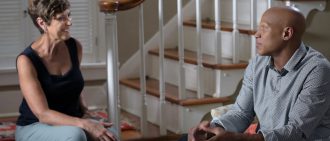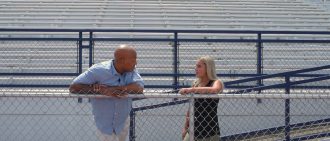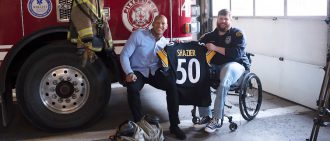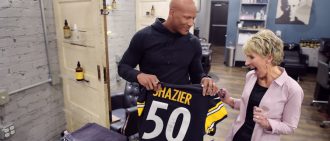During one of Joe Aigner’s many hospital visits, staff members dubbed him “the miracle man.”
“They always would make (jokes),” Joe says. “You know, ‘Here comes the miracle man.’”
The name seems to fit. Over the course of about a year, Joe dealt with no fewer than five medical setbacks. That total includes a battle with esophageal cancer – a particularly lethal form of the disease – and open-heart surgery.
During that year, Joe went through radiation, chemotherapy, multiple surgeries, side effects, a feeding tube, and more. But he kept waking up every day, ready to take on the next challenge. He remained motivated to stay alive for his wife and young daughter.
“I knew I would do whatever it was going to take to get through this,” Joe says.
Joe did just that, overcoming every sickness and injury. Cancer-free for nine years, he knows it took a miracle – but the miracle didn’t come from himself.
“I’m not ‘the miracle man,’” he says. “I’m the miracle of prayer and modern medicine. And it’s a miracle that they had me walk out of there every time.”
Ryan Shazier’s 50 Phenoms Season 1
‘You Never Want to Think the Worst’
Joe sat down for dinner on the Fourth of July in 2010. He cut a piece of steak, put it into his mouth, chewed, and attempted to swallow.
He couldn’t. The food wouldn’t go down, despite his best attempts.
“There was something happening,” Joe says. “Still, I just felt that maybe I swallowed wrong or something. You never want to think the worst, of course.”
Joe’s wife, Carol, is an emergency nurse and determined he should go to the hospital for some tests. , Joe returned to the hospital the next day for an endoscopy. Doctors inserted a small, flexible tube with a camera and light attached through the mouth and into the esophagus to look for problems.
The procedure revealed a tumor. A biopsy showed Joe had esophageal cancer.
“It was completely unexpected,” Carol Aigner says. “There is no family history for Joe, so it was rather devastating.”
Esophageal cancer is rare in the United States. It’s also deadly: The five-year survival rate for the disease in the United States is under 20 percent. It’s especially deadly at later stages, when the cancer advances to other parts of the body like the lungs or the liver.
“The outcomes are certainly a lot better if it’s picked up before it spreads,” says John Rhee, MD, a medical oncologist and hematologist at UPMC Hillman Cancer Center.
Joe was diagnosed with stage IV esophageal cancer, with scans revealing the tumor had spread to the lymph nodes in his neck.
“That’s a life-changing experience right there, when anybody tells you you have cancer,” Joe says.
Joe had no plans of dying – his daughter, Izabela, was 3 years old at the time of the diagnosis, and he says, he wasn’t “going to leave her.”
Doctors recommended he put his affairs in order, just in case, adding they would give him the best chances of ensuring he would survive.
“(They said) we’ll do everything we can,” Joe says. “We have very good outcomes from it, but it’s going to take a lot of perseverance on your part.”
Never Miss a Beat!
Subscribe for articles and more from Ryan Shazier’s 50 Phenoms.
Thank you for subscribing!
You can now select the specific newsletters you'd like to receive.
You are already subscribed.
Subscribe to more newsletters in our email preference center.
Sorry, an error occurred. Please try again later.
Receive text updates from Ryan Shazier’s 50 Phenoms.
‘I’m Not Going to Die Today’
Joe was ready to persevere. He just didn’t know how much he’d need to overcome.
Because of his swallowing problems, Joe needed a feeding tube. Then came a round of radiation and chemotherapy that lasted around two months. The best way to beat esophageal cancer requires multiple types of treatment, Dr. Rhee says, meaning radiation, chemotherapy, and surgery.
“Unless it’s very early stage, we often involve more than one modality,” Dr. Rhee says. “We work with the surgeon and the radiation oncologist.”
After the first round of radiation and chemotherapy, Joe’s scans revealed the tumor hadn’t shrunk, so he would need another round of both treatments.
This time the scans came back with a smaller tumor. But because of all his treatments, Joe began to notice some nasty side effects.
“There’s nobody that enjoys chemo and radiation,” Joe says. “The first one, you go, ‘Oh, I can deal with this.’ You just don’t realize that’s just a small dose, and once it starts to build in your system, it kind of gets a little more restrictive, so to speak. And that’s kind of when the side effects start to take place.”
Smaller side effects included a coppery taste, like “if you put a penny in your mouth,” and an inability to touch or drink anything cold.
But bigger problems began to crop up: One morning, Joe found he couldn’t stand when he got out of his bed because his feet were swollen. He was diagnosed with gout, a form of arthritis that causes pain, inflammation, and swelling in joints.
After getting treatment for the gout, Joe woke up three weeks later with shingles – a rash that comes from the same virus that causes chickenpox – on his back. After children get chickenpox, the virus remains dormant in their bodies; it can come back later in life as shingles, particularly in people with weakened immune systems.
In Joe’s case, chemotherapy’s effect on his immune system potentially led to the side effects like gout and shingles.
“It just starts to get to the point (where) you have to laugh,” Joe says. “You have to move through it. You just sit there, and you go, ‘Well, it’s just another day. We’ve got to just keep moving on.”
At one point, Joe’s weight dropped below 100 pounds. He couldn’t pick up and hold his daughter, an especially difficult blow for him. But he knew he had to keep fighting.
“It was just a day by day,” Joe says. “You know, you just get up every day, and you say to yourself, ‘I’m not going to die today.’”
‘We Worked Together’
Joe’s doctors planned to remove the tumors from the lymph nodes in his neck and his esophagus after his second round of chemotherapy. Those plans changed – doctors removed the cancer from his neck, but the tumor in his esophagus was still too large for resection.
After another round of chemotherapy, Joe was ready for the esophagus surgery – or so he thought.
While Joe took a routine pre-surgery stress test, his doctors noticed some abnormalities. Further tests revealed four blockages to the arteries supplying blood to his heart. Joe would need heart surgery before doctors could address the tumor in his esophagus.
“That was another one of those moments that you started to reflect again,” Joe says. “It was like, really?”
Doctors performed coronary artery bypass grafting (CABG), the most common type of open-heart surgery. The procedure uses blood vessels from other parts of the body and connects them to the blood vessels surrounding the blocked arteries, bypassing them, to restore normal blood flow.
Joe came through his CABG procedure safely, setting him up for his esophagectomy a month later.
“(My doctor said), ‘The four bypasses is going to feel like you got hit by a bus,’” Joe says. “But the esophageal resection, being that it’s over 14 hours, will feel like you’ve been hit by a freight train.’ And you’ll make it back, but it’s not going to be fun.”
Joe made it through the 14-hour procedure, which also included a medically induced coma for two days after the surgery.
The surgery was successful. The tumor was removed. But even then, Joe had one more setback after his feeding tube was removed for the last time.
“My daughter had been waiting patiently for nearly a year for me to be able to pick her up again,” Joe says. “So as soon as I got that OK, she was excited to have me pick her up. I pick her up, and immediately I had this pain in my back. I felt a pop.”
Two of Joe’s vertebrae in his back had collapsed, yet another side effect of all the chemotherapy and radiation. One more surgical procedure fixed that, finally putting Joe back together again.
“We were a family, we did it, and we worked together,” Carol Aigner says. “Since I’ve known Joe, actually, he does not accept defeat. That’s not in the vocabulary.”
‘I’m Going to Make the Best of Every Day’
For someone who went through so many serious health challenges in a short time, Joe lives a normal life with Carol and their daughter Izabela, now 13 years old.
Some things have changed, however. Joe and Carol started their own small business, one that he hopes one day to pass along to Izabela.
He’s already passed on his passion for golf, a sport that helped him get through his trying times. He would watch The Golf Channel sometimes while sick, and sometimes he would go out to hit a few balls in his yard. Now Izabela plays, and plays expertly – she is the top-ranked female golfer at her age division in southwestern Pennsylvania.
“I’m very proud of my dad, from what he has conquered throughout the couple of years of the cancer,” Izabela says. “I’m just so proud of him that he kept on fighting when you could have easily given up. He never gave up hope.”
Part of that was Joe’s motivation to survive for Izabela – “I just couldn’t see having her grow up without me,” he says – and Carol.
He also is thankful for all the help he received from family and friends during his health problems. Carol took charge of his care, calling doctors and setting up appointments. Friends and neighbors were there to watch Izabela or provide other assistance. Even Izabela, 4 years old at the time, helped by making peanut butter sandwiches for Joe or staying with him.
“There’s no I in team, there really isn’t,” Joe says. “You need family to help you out. And then, once you get there, the doctors that you need, it’s a team of doctors. From the oncologist, to the surgeons, the radiology department.”
Nine years cancer-free, Joe says he hopes and prays that it will never come back. But the ordeal put everything in perspective, allowing him to view everything in his life as a blessing.
“You take a look at every day as a new day,” he says. “And I’m going to make the best of every day because you just never know what’s going to happen tomorrow. And you can’t worry about it because you can’t change it. You just have to persevere and push through and have the hope that everything works out well.”
About UPMC
Headquartered in Pittsburgh, UPMC is a world-renowned health care provider and insurer. We operate 40 hospitals and 800 doctors’ offices and outpatient centers, with locations throughout Pennsylvania, Maryland, New York, West Virginia, and internationally. We employ 4,900 physicians, and we are leaders in clinical care, groundbreaking research, and treatment breakthroughs. U.S. News & World Report consistently ranks UPMC Presbyterian Shadyside as one of the nation’s best hospitals in many specialties and ranks UPMC Children’s Hospital of Pittsburgh on its Honor Roll of America’s Best Children’s Hospitals. We are dedicated to providing Life Changing Medicine to our communities.







